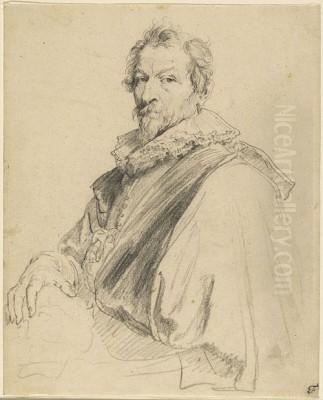
Hendrik van Balen the Elder stands as a significant figure in the rich tapestry of Flemish Baroque art. Active during the late 16th and early 17th centuries, his life and career unfolded primarily in Antwerp, a bustling hub of artistic innovation and commerce. While sometimes overshadowed by the towering reputations of his contemporaries like Peter Paul Rubens and his own pupil Anthony van Dyck, Van Balen carved a distinct niche for himself, celebrated for his refined mythological and religious scenes, his influential role as a teacher, and his prolific collaborations with other leading artists of his time. His generally accepted lifespan, confirmed by numerous historical sources, is from 1575 to 1632, placing him squarely within the Golden Age of Antwerp painting.
Born in Antwerp, Hendrik van Balen entered a world poised for artistic resurgence. His family background provided a solid foundation for his future pursuits. His father, Willem van Balen, was a merchant, suggesting a degree of financial stability. Some sources even mention his mother's connection to economic analysis, hinting at a household valuing intellect and commerce. This environment likely contributed to Van Balen receiving a comprehensive education, reportedly becoming proficient in several languages including French, Dutch, Italian, Spanish, and English, skills that would prove invaluable in the cosmopolitan art world and during his travels.
Early Training and Italian Influence
Van Balen's formal artistic training took place within the established structures of Antwerp's renowned Guild of Saint Luke. His primary master was Adam van Noort, a respected painter who also, notably, taught Peter Paul Rubens and Jacob Jordaens. There is speculation that Van Balen may have also studied briefly with Marten de Vos, another influential Antwerp artist known for his historical and religious paintings. This early training grounded him in the Flemish tradition, emphasizing craftsmanship and detailed observation.
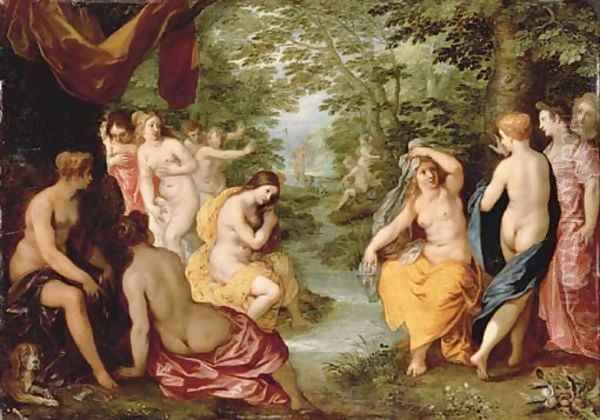
By 1592 or 1593, Van Balen achieved the status of Master within the Guild of Saint Luke, a crucial step signifying his professional independence. Shortly after, like many ambitious Northern European artists of his generation, he embarked on a formative journey to Italy. This period, likely spanning the late 1590s and possibly extending into the early 1600s, was pivotal in shaping his artistic sensibilities. While specific details of his itinerary remain debated, his time spent absorbing the masterpieces of the Italian Renaissance and contemporary Italian art left an indelible mark on his style.
Exposure to the works of the Venetian school, with its emphasis on rich color, atmospheric effects, and sensual forms, is particularly evident in Van Balen's later output. His handling of light and color became more nuanced, and his depiction of the human form, especially the nude, gained a classical elegance and softness often associated with Italian ideals. It was also during his time in Italy that he likely strengthened connections with fellow Flemish artists abroad, including Peter Paul Rubens, fostering relationships that would continue upon their return to Antwerp.
Artistic Style: Myth, Religion, and Refinement
Upon returning to Antwerp, Van Balen established himself as a leading painter, developing a distinctive style that blended Flemish precision with Italianate grace. He became particularly renowned for his cabinet paintings – small, finely executed works often painted on copper or wood panels. These intimate pieces were highly sought after by Antwerp's wealthy merchants and collectors for their private galleries and residences.
Van Balen's subject matter frequently drew from Greco-Roman mythology and Christian scripture. He possessed a deep understanding of classical literature, often depicting scenes from Ovid's Metamorphoses with narrative clarity and charm. His mythological paintings typically feature elegant, often nude figures set within idyllic landscapes or classical architecture. Works like Diana and Actaeon showcase his ability to render the human form with sensitivity and to use light and shadow to create mood, capturing moments of drama or quiet contemplation.
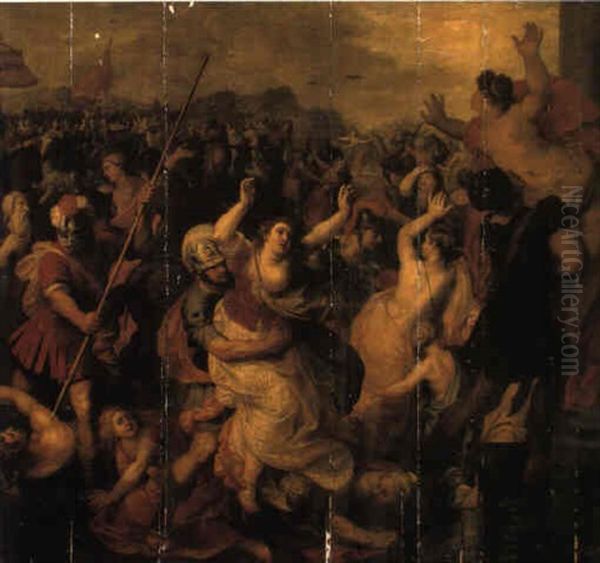
His religious paintings, including numerous altarpieces, demonstrate a similar refinement. Early works, such as a Resurrection, might show stronger ties to late Mannerist traditions, but his style evolved towards a more harmonious and coloristically rich Baroque sensibility. He executed commissions for important religious institutions, including several altarpieces for Antwerp's St. James' Church, contributing significantly to the city's religious art landscape. Throughout his oeuvre, a consistent feature is the elegance and grace of his figures, particularly his female nudes, rendered with smooth brushwork and delicate attention to detail. While clearly a Baroque artist, his style often favored refinement and lyrical beauty over the high drama and dynamic energy found in the works of Rubens. He also reportedly worked as a stained-glass designer, though fewer examples of this aspect of his work survive.
A Hub of Collaboration
One of the most defining aspects of Hendrik van Balen's career was his extensive collaboration with other prominent Antwerp artists. This practice was common in the highly specialized Antwerp art market, allowing painters to leverage each other's strengths. Van Balen, highly respected for his skill in figure painting, frequently partnered with masters renowned for landscapes, still lifes, or animals.
His most famous and enduring collaboration was with Jan Brueghel the Elder. The two artists were close friends, and their combined efforts resulted in numerous masterpieces. In these works, Van Balen typically painted the figures – gods, goddesses, nymphs, or biblical characters – while Brueghel executed the lush landscapes, detailed floral arrangements, or abundant displays of fruit and animals. Paintings like the Allegory of the Four Elements or the Allegory of Abundance exemplify this successful partnership, creating harmonious compositions rich in detail and symbolic meaning. Their joint work Diana and Callisto is another prime example held in high esteem.
Van Balen also collaborated frequently with the landscape specialist Joost de Momper the Younger. In these paintings, Van Balen would add the figures, often small-scale staffage, to De Momper's expansive and often mountainous vistas. Landscape with Pilgrims in a Grotto Chapel illustrates this type of joint venture, integrating narrative elements into a dramatic natural setting.
His collaborative network extended further. He worked with the renowned animal and still-life painter Frans Snyders. A notable example is Diana and her nymphs after the hunt, where Van Balen's elegant figures are complemented by Snyders' dynamic depiction of hunting dogs and game within a landscape setting. After the death of Jan Brueghel the Elder in 1625, Van Balen continued the tradition by collaborating with his son, Jan Brueghel the Younger, on works such as the Massacre of the Innocents. These collaborations underscore Van Balen's central position within the Antwerp artistic community and his ability to work harmoniously with diverse talents.
The Teacher: Shaping the Next Generation
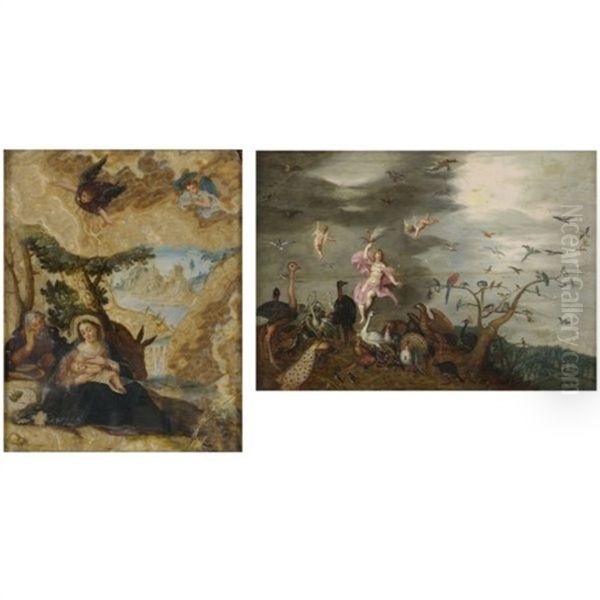
Beyond his own prolific output and collaborations, Hendrik van Balen was a highly influential teacher, running a successful workshop that trained numerous pupils. His reputation attracted aspiring artists, and his guidance played a crucial role in shaping the next generation of Flemish painters.
His most celebrated student was undoubtedly Anthony van Dyck. Van Dyck entered Van Balen's studio around 1617, receiving foundational training before moving on to work with Rubens. Van Balen's influence is discernible in Van Dyck's early works, particularly in the elegant rendering of figures and the refined handling of paint. Sources suggest Van Dyck closely studied and even imitated his master's style during his apprenticeship, highlighting the impact Van Balen had on the young prodigy's development.
Frans Snyders, though primarily known as a collaborator, is also listed in some records as having been a student of Van Balen. Other documented pupils include Jacob van Leiden (whose identity requires further clarification) and likely many others whose names are lost to history or less prominent. The sheer number of students passing through his workshop attests to his status and the respect he commanded as both an artist and an educator. His role as a mentor cemented his legacy, extending his influence far beyond his own lifetime through the successful careers of those he trained.
Prominence in Antwerp Society
Hendrik van Balen was not merely a successful artist; he was a respected and influential member of Antwerp society. His standing within the artistic community was formally recognized through his active participation in the Guild of Saint Luke. Having become a Master in 1592/93, he rose through the ranks, serving as the second dean possibly as early as 1593, and later holding the prestigious position of first dean in 1608-1609. These roles involved administrative responsibilities and underscored his leadership within the profession.
His influence extended beyond the Guild. In 1613, he was elected as a member of the Antwerp City Council, indicating his involvement in civic affairs and his esteemed position among the city's elite. His professional success translated into considerable wealth. He owned a luxurious residence in Antwerp and was known to be a collector himself, possessing a range of artworks and valuable objects. This combination of artistic achievement, teaching success, guild leadership, civic participation, and personal wealth paints a picture of Van Balen as a central and highly regarded figure in early 17th-century Antwerp.
Major Works and Their Dispersal
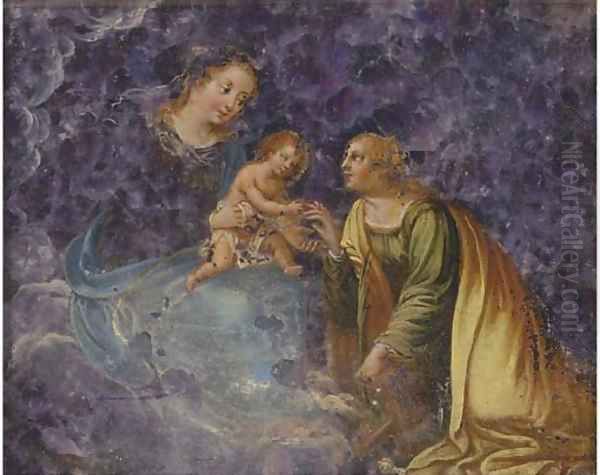
Hendrik van Balen's oeuvre was extensive, though identifying and locating all his works today presents challenges common in art history. Many of his signature cabinet paintings, prized for their detail and intimate scale, have found their way into major museum collections and private hands across the globe.
Key representative works include:
Diana and Actaeon: A fine example of his mythological scenes on copper, noted for its delicate handling of light and classical figures. One version is held by the Rijksmuseum in Amsterdam.
Achilles Recognized Among the Daughters of Lycomedes: This larger panel painting, housed in the Royal Museum of Fine Arts Antwerp (KMSKA), showcases his ability to handle multi-figure compositions and narrative complexity.
The Rape of the Sabines: A significant work, demonstrating his engagement with dramatic historical themes, which appeared on the art market, sold at Christie's in New York in 1996.
Assumption of the Virgin: An oil painting indicating his contribution to religious art, once part of the prestigious collection of Tsar Nicholas I of Russia, its current location might be a private collection in Zurich.
Allegory of Air: Dated towards the end of his career (c. 1630-1635), this work, now in the Art Institute of Chicago, represents his continued engagement with allegorical themes, likely part of a series depicting the elements.
Saint Catherine: While the original painting is considered lost, its existence points to the breadth of his religious subject matter, likely created in the 1620s.
His collaborative works are also well-represented in collections worldwide. The Rijksmuseum holds examples of his partnerships with Jan Brueghel the Elder, such as Landscape with Still Life and Diana and Callisto. Many other collaborations with Brueghel, Joost de Momper, and Frans Snyders can be found in institutions like the Prado Museum in Madrid, the Louvre in Paris, and numerous other European and American museums. The dispersal of his works attests to their enduring appeal and historical importance.
Academic Perspectives and Legacy
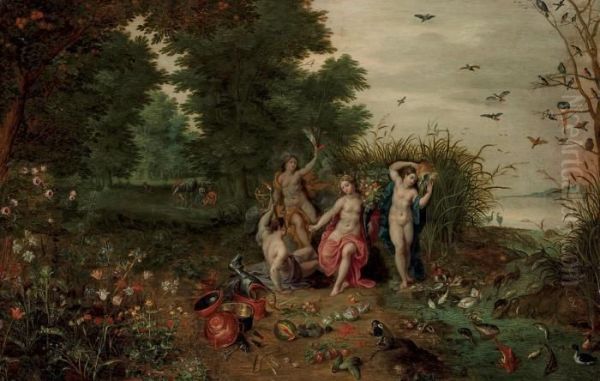
In art historical scholarship, Hendrik van Balen is recognized as a pivotal figure in the Flemish Baroque, particularly for his role in reviving figure painting in Antwerp around the turn of the 17th century and for his mastery of the cabinet painting genre. Academics praise his technical skill, the elegance of his figures, his sophisticated use of color, and his knowledgeable handling of mythological and allegorical themes, often derived from classical sources like Ovid. His influence as a teacher, especially on Anthony van Dyck, is universally acknowledged as a significant contribution to the trajectory of Flemish art.
However, his historical assessment is not without nuances or points of debate. Some critics argue that his artistic reputation has been somewhat eclipsed by the monumental achievements of Rubens and Van Dyck, leading to periods where his contributions were relatively underestimated. His heavy reliance on collaboration has also occasionally led to discussions about originality, with some viewing him more as a highly skilled specialist within a workshop system rather than a singular, innovative genius in the mold of Rubens.
Furthermore, while his refinement and elegance are praised, some scholars find his work occasionally lacking the dramatic power or emotional depth of his more famous contemporaries, sometimes perceiving a reliance on established formulas or traditional themes. Despite these debates, the consensus remains that Van Balen was a highly accomplished, influential, and historically important artist. His ability to synthesize Italianate grace with Flemish precision, his central role in Antwerp's collaborative art scene, and his impact as a teacher secure his place as a key master of the Flemish Baroque.
Hendrik van Balen died in Antwerp in 1632, the same year as his friend and collaborator Jan Brueghel the Elder passed away, marking the end of an era for Antwerp painting. He left behind a substantial body of work, a thriving workshop possibly continued by his sons (Jan van Balen and Gaspard van Balen, also painters), and a legacy carried forward by his numerous students. His art, characterized by its elegance, refinement, and harmonious integration of figures within detailed settings, continues to be appreciated in museums and collections worldwide, offering a window into the sophisticated tastes and collaborative spirit of Antwerp's Golden Age. He remains a testament to the diverse talents that flourished during the Flemish Baroque, a master of myth, mentor to genius, and a vital node in the intricate network of artistic creation.